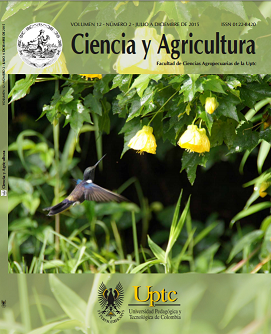Water requirements of carrot (D. carota L.) ln three stages of development

Abstract
Among the main production systems in the department of Boyaca is the carrot (D. carota L.), which participates with 1093 ha, especially in Ventaquemada, Samaca and Tunia municipalities. The Chantenay hybrids Ventaquemada have an average yield of 20 t.ha-1, which is low compared to the Sabana de Bogota 28.1 t.ha-1. Limiting production factors in the area are: lack of irrigation, absence of high agronomic requirements seeds (appropriate mechanization soil, proper fenilizationn.), and presence of pathogens and weeds. The purpose of this paper was to find the water requirements of the crop in three phenological phases (growth, maturity and Elongation harvestable organ). lt was developed in the second half of 2014, in \/entaquemada, Bojirque path; the assessment phase was carried out under a stratified sampling design, destructive samples were taken every 30 days from planting. The Kc value was determined using the methodology proposed by FAO.
Two lysimeters of 1 m3 capacity were installed in order to establish the water consumption of the crop. ETo was obtained with the climatic data taken by the wireless weather station Ambient Weather WS-2080 installed on the site, which is analyzed through the Penman-lvionteith CROPWAT leaning the software. The Kc for each phenological stage was: 0.14 growth phase, 0.29 elongation phase, and 0.55 maturity phase of harvestable organ.
Keywords
vegetable, crop coefficient, evapotranspiration crop, irrigation, carrot production.
References
- Rubatzky VE, Quros CF, Simon PW. Carrots and related vegetable Unbelliferae. Crop Production Science in Horticulture Series, n° 10. CABI Publishing, 1999; UK. 294 pp.
- Suojala T. Pre- and Postharvest Development of Carrot Yield and Quality. Agricultural Research Centre of Finland, Helsinky, 2000.
- FAO. Dirección de Estadística. 2013. Disponible en: http://faostat3.fao.org/download/Q/QC/S.
- Agronet. 2014. Disponible en: http://www.agronet.gov.co/agronetweb1/Estad%-C3%ADsticas.aspx.
- Domínguez A, de Juan JA, Tarjuelo JM, Martínez RS, Martínez-Romero A. Determination of optimal regulated deficit irrigation strategies for maize in a semi-arid environment. Agric. Water Manage.2012; 110: 67-77. DOI: http://dx.doi.org/10.1016/j.agwat.2012.04.002.
- Gaviola J. Manual de producción de zanahoria. Mendoza, Argentina: INTA; 2013; 97-98.
- Bleiholder H, Buhr L, Feller H, Hack R, Klose H, Hess R, Stauss U, Meier T, Weber E. Compendio para la identificación de los estadios fenológicos de especies mono- y dicotiledóneas cultivadas - Escala BBCH Extendida. 2008. Ciba-Geigy AG. Basilea.
- FAO. Evapotranspiración del Cultivo: Guías para la determinación de los requerimientos de agua de los cultivos. Manual No. 56 Serie Riego y Drenaje. 2006; FAO Roma, Italia.
- Castro H, Cely G, Vásquez S. Criterios técnicos para un manejo eficiente del riego en cebolla de bulbo, distrito de riego Alto Chicamocha. Boyacá,Colombia: Universidad Pedagógica y Tecnológica de Colombia; 2009.
- Pinzón R. Manual para el cultivo de hortalizas. Bogotá: Produmedios; 2012.
- Vega Rojas T, Méndez Soto C, Rodríguez Montero W. Análisis del crecimiento de cinco híbridos de zanahoria (D. carota L.) mediante la metodología del análisis funcional. Agronomía Costarricense, 2012; 36(2): 29-46.
- Strandberg J. Monitoring growth and development of carro ton organic solis in Florida. Proc. Fla. State Hort. Soc.2001, 114: 307-312.
- Matute M, Hoyos P. Influencia de la distribución de las líneas de siembra en las mesetas de cultivo sobre la producción y calidad de la zanahoria CV, Tesis de maestría, Escuela Universitaria de Ingeniería Técnica Agrícola, Universidad Politécnica de Madrid, 2008.
- Enciso Z. Evaluación de zanahorias sembradas en verano. Investigación Agraria, 2011; 13(2): 75-79.
- Nozumu M. Embrapa Hortalizas. Sistema de Producão. Brasilia, BR, 2000. Disponible en: www.cnph.embrapa.br/public/folders/cultivodecenoura.html.
- Allen RG, Pereira LS, Raes D, Smith M. Evapotranspiración del cultivo: Guías para la determinación de los requerimientos de agua de los cultivos. Estudio FAO Riego y Drenaje No. 56. Organización de las Naciones Unidas para la Agricultura y la Alimentación (FAO). 2006; Roma. 298.
- Fernández Gómez R., Ávila Alabarces R, López Rodríguez M, Gavilán Zafra P, Oyonarte Gutiérrez N. Manual de riego para agricultores, Módulo I. Fundamentos de riego. Andalucía. (2010). Signatura Ediciones de Andalucía, S.L.
- FAO. La calidad en frutas y hortalizas. En: Manual para la preparación y venta de frutas y hortalizas: del campo al mercado. Depósito de Documentos de la FAO. 2006. Disponible en http://www.fao.org//docrep/006.
- Benacchio SS. Algunas exigencias agroecológicas en 58 especies de cultivo con potencial de producción en el Trópico Americano. FONAIAP-Centro Nal. de Inv. Agropecuarias. Ministerio de Agricultura y Cría. Maracay, Venezuela. 1982; 202 p.